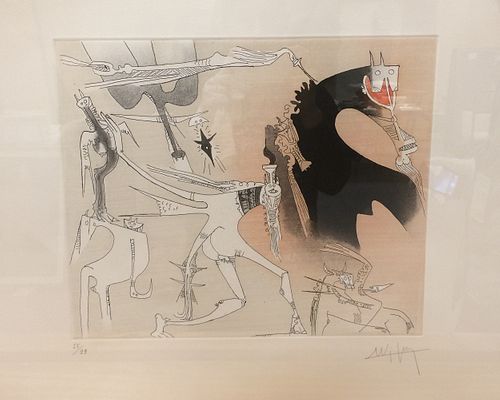*Wifredo LAM (Cuba 1902-1982) / untitled
About Seller
628 Alamitos Avenue
Long Beach, CA 90802
United States
The Museum of Latin American Art (MOLAA) was founded in 1996 in Long Beach, California and serves the greater Los Angeles area. MOLAA is the only museum in the United States dedicated to modern and contemporary Latin American and Latino art. Since its inception, MOLAA has doubled its size and added ...Read more
Two ways to bid:
- Leave a max absentee bid and the platform will bid on your behalf up to your maximum bid during the live auction.
- Bid live during the auction and your bids will be submitted real-time to the auctioneer.
Bid Increments
| Price | Bid Increment |
|---|---|
| $0 | $50 |
| $500 | $100 |
| $1,000 | $200 |
| $5,000 | $500 |
| $10,000 | $1,000 |
| $20,000 | $2,000 |
About Auction
Dec 6, 2020
Modern and Contermporary Latin American and Latino Fine Art Auction. Gems from our vault and more... Over 120 lots of serious Latin and Latin American Artist from the 1950's to the present. Most works have been exhibited or published by the Museum. Museum of Latin American Art auction@molaa.org
- Lot Description
*Wifredo LAM (Cuba 1902-1982) Sin título , 1979 Etching on paper Edition # 13 x 15 1/2 Inches. This work is framed. *This is a Museum Deaccession. Dimensions 13 x 15 1/2 Inches Artist or Maker Lam, Wifredo (Cuba 1902-1982). *This is a Museum Deaccession. Medium Etching on paper Date 1979 Condition Report Good condition. Provenance Provenance. Gift of Mr. Russell Faucett Notes Wifredo Lam Cuba b. Sagua la Grande, Cuba 1902 d. Paris, France 1982 Wifredo Oscar de la Concepción Lam y Castilla was born December 8, 1902, in Sagua la Grande, Cuba. In 1916, his family moved to Havana, where he attended the Escuela de Bellas Artes. During the early 1920s, he exhibited at the Salón de la Asociación de Pintores y Escultores in Havana. In 1923, Lam moved to Madrid, where he studied at the studio of Fernando Alvarez de Sotomayor, the Director of the Museo del Prado (and a teacher of Salvador Dalí). In 1929, Lam married Eva Piriz, who died of tuberculosis two years later, as did their young son. This tragic event may have contributed to the dark and brooding appearance of much of Lam’s later work. In the early 1930s, the effects of Surrealism were evident in Lam’s work, as was the influence of Henri Matisse and possibly Joaquín Torres-García. In 1936, a traveling exhibition of the work of Pablo Picasso shown in Barcelona, Bilbao, and Madrid proved inspirational to Lam both artistically and politically. He moved to Paris in 1938, where Picasso took him under his wing and encouraged his interest in African art and primitive masks. During that year, he also traveled to Mexico, where he stayed with Frida Kahlo and Diego Rivera. Lam’s own multicultural heritage (as the son of a Chinese father and a mother of mixed African, Indian, and European descent) and his involvement with Santería, a religion rooted in African culture, would soon become integral to his work. By the late 1930s, Lam was associated with the Surrealists. He had his first solo show at the Galerie Pierre Loeb in Paris in 1939, and his work was exhibited with Picasso’s at the Perls Galleries, New York. During World War II, Lam spent most of his time in the Caribbean, along with Claude Lévi-Strauus, André Masson, and André Breton, whose poem “Fata Morgana” Lam illustrated in 1940. Lam eventually made his way back to Havana in 1941. His first year in Cuba marked a watershed in his artistic development; he was introduced to the theories of Carl Jung, and by the end of 1942 he had begun his powerful painting Jungle. Lam’s exploration of mythic images paralleled that of his contemporaries in New York, the Abstract Expressionists, though Lam used specific subject matter. Lam created his own style by fusing Surrealism and Cubism with the spirit and forms of the Caribbean. Between 1942 and 1950, the artist exhibited regularly at the Pierre Matisse Gallery in New York. His second marriage, to Helena Holzer in 1944, ended in divorce in 1950. In 1946, after a four-month stay in Haiti, Lam returned to France via New York. In 1948, he met Asger Jorn, who was a friend for many years. He traveled extensively until 1952, then settled for three years in Paris before resuming his travels again in 1955. In 1960, Lam established a studio in Albisola Mare, on the Italian coast. The winter of that year he married Swedish painter Lou Laurin, with whom he would have three sons. In 1964, he received the Guggenheim International Award, and in 1966–67 there were multiple retrospectives of Lam’s work at the Kunsthalle Basel; the Kestner-Gesellschaft, Hannover; the Stedelijk Museum, Amsterdam; the Moderna Museet, Stockholm; and the Palais des Beaux-Arts, Brussels. Lam died September 11, 1982, in Paris. -https://www.guggenheim.org/artwork/artist/wifredo-lam
Dimension
Height: 13.00Depth: 15.50Depth: 15.50Good condition.Condition
- Shipping Info
-
SHIPPING, PAYMENT & AUCTION POLICIES TAXES Long Beach, CA Local Taxes Apply 10.25% unless is being shipped out of the state or resale number is provided. PACKING & SHIPPING 1) Buyer pays packing and shipping costs and is responsible for contacting shipping company of his choice. MOLAA will provide a list of local packing and shipping companies in the area. 2) Curb-side pick up will be available at the museum, according to guidelines and regulations the city imposes during the week of December 7th 2020.
-



 EUR
EUR CAD
CAD AUD
AUD GBP
GBP MXN
MXN HKD
HKD CNY
CNY MYR
MYR SEK
SEK SGD
SGD CHF
CHF THB
THB











